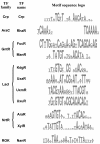Polysaccharides utilization in human gut bacterium Bacteroides thetaiotaomicron: comparative genomics reconstruction of metabolic and regulatory networks
- PMID: 24330590
- PMCID: PMC3878776
- DOI: 10.1186/1471-2164-14-873
Polysaccharides utilization in human gut bacterium Bacteroides thetaiotaomicron: comparative genomics reconstruction of metabolic and regulatory networks
Abstract
Background: Bacteroides thetaiotaomicron, a predominant member of the human gut microbiota, is characterized by its ability to utilize a wide variety of polysaccharides using the extensive saccharolytic machinery that is controlled by an expanded repertoire of transcription factors (TFs). The availability of genomic sequences for multiple Bacteroides species opens an opportunity for their comparative analysis to enable characterization of their metabolic and regulatory networks.
Results: A comparative genomics approach was applied for the reconstruction and functional annotation of the carbohydrate utilization regulatory networks in 11 Bacteroides genomes. Bioinformatics analysis of promoter regions revealed putative DNA-binding motifs and regulons for 31 orthologous TFs in the Bacteroides. Among the analyzed TFs there are 4 SusR-like regulators, 16 AraC-like hybrid two-component systems (HTCSs), and 11 regulators from other families. Novel DNA motifs of HTCSs and SusR-like regulators in the Bacteroides have the common structure of direct repeats with a long spacer between two conserved sites.
Conclusions: The inferred regulatory network in B. thetaiotaomicron contains 308 genes encoding polysaccharide and sugar catabolic enzymes, carbohydrate-binding and transport systems, and TFs. The analyzed TFs control pathways for utilization of host and dietary glycans to monosaccharides and their further interconversions to intermediates of the central metabolism. The reconstructed regulatory network allowed us to suggest and refine specific functional assignments for sugar catabolic enzymes and transporters, providing a substantial improvement to the existing metabolic models for B. thetaiotaomicron. The obtained collection of reconstructed TF regulons is available in the RegPrecise database (http://regprecise.lbl.gov).
Figures






References
Publication types
MeSH terms
Substances
Grants and funding
LinkOut - more resources
Full Text Sources
Other Literature Sources
Molecular Biology Databases
Miscellaneous

